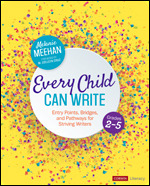Every Child Can Write, Grades 2-5
Entry Points, Bridges, and Pathways for Striving Writers
- Melanie Meehan - Simsbury Public Schools
Foreword by M. Colleen Cruz
Corwin Literacy
Empowering striving writers to thrive as writers!
Somehow, in every classroom during every year, there are students who keep us up at night because of the instructional challenges they face as writers. These students—our striving writers—may find success exploring different entry points and pathways than those their classmates travel.
Every Child Can Write will help you lead striving writers along their journey toward growth, confidence, and success. Filled with practical strategies, classroom-management ideas,and reproducible tools, this book also offers low- and high-tech solutions for increasing writing volume and boosting self-esteem.
Plus, with suggestions for differentiating instruction based on standards and student needs, it will help you:
- Implement principles of UDL to optimize your classroom environment and student learning;
- Identify and honor students’ strengths throughout your writing instruction;
- Maximize the power of formative assessment to set goals with students; and
- Integrate the most appropriate technology that empowers students and leads them to independence.
As essential as writing is in elementary school, it will be even more important when your students reach middle school. Now is the time to give them the skills, practice, and confidence they need to succeed.
To address distance learning, Melanie Meehan has created a free resource available at corwin.com/everychildcanwritefreeresources. As we know, in distance learning caregivers and teachers partner more than ever to help students with writing. The Distance Learning companion to Every Child Can Write is for teachers to share with caregivers to help children develop their writing lives—even while learning at home. Each of the eight modules contains video clips that talk caregivers through tools for supporting their student writers, along with downloadable tools that can be used by teachers or caregivers.
Free resources
How to Use Backward Chaining to Differentiate Instruction
Check out this podcast episode from author Melanie Meehan and Cult of Pedagogy.
The Distance Learning Companion to Every Child Can Write
In distance learning, caregivers and teachers partner more than ever to help students with writing. Melanie Meehan created this companion to Every Child Can Write for teachers to share with caregivers to help children develop their writing lives—even while learning at home. Each of the eight modules contains video clips that talk caregivers through tools for supporting their student writers, along with downloadable tools that can be used by teachers or caregivers.
Want More Teaching Time? Shorten Transitions… Here’s How
Instructional time is a precious commodity, so it’s worth thinking about ways to make transitions as efficient as possible. In this blog post from Every Child Can Write author Melanie Meehan, she explains that, when we teach explicit strategies for transitioning smoothly and efficiently, we unlock more time for instruction.
Where and How Students Get Stuck in their Process—and How to Help Them Out
In this excerpt from Every Child Can Write, Grades 2-5, by Melanie Meehan, you’ll discover how to determine where and how students get stuck in their process, and how we can help them find the right entry point.

